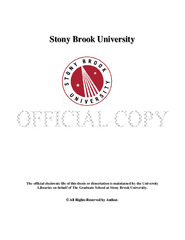| dc.identifier.uri | http://hdl.handle.net/1951/55974 | |
| dc.identifier.uri | http://hdl.handle.net/11401/70809 | |
| dc.description.sponsorship | This work is sponsored by the Stony Brook University Graduate School in compliance with the requirements for completion of degree. | en_US |
| dc.format | Monograph | |
| dc.format.medium | Electronic Resource | en_US |
| dc.language.iso | en_US | |
| dc.publisher | The Graduate School, Stony Brook University: Stony Brook, NY. | |
| dc.type | Thesis | |
| dcterms.abstract | Abstract of the Thesis <bold>The utilization of landscape in Grazia Deledda.</bold> by Angela Cortes Master of Arts in Romance Languages and Literature Italian Stony Brook University 2011 Many authors and poets use landscape and nature to portray to the reader specific information regarding the characters, their feelings and thoughts, as well as the author's own frame of mind, and the historical time frame of the novel. Other authors may use the landscape as a physical representation, to portray feelings and thoughts which could not be represented otherwise. Grazia Deledda, awarded the Nobel Prize in Literature in 1926, is one such author: she uses the landscape of her home town, Nuoro, and of her island, Sardegna, in her novels. This thesis analyzes how Deledda uses her scenery, its ultimate purpose, and whether or not she is consistent in her utilization of the Sardinian landscape and nature throughout her work. In order to provide an adequate theoretical background, I begin my analysis by considering how other Italian writers of the same historical period use nature in their works. In fact, Deledda is often associated with the writers of verismo and naturalismo of post-unification Italy because of their use of the landscape in an effort to accurately represent Italian regional societies. I chose to analyze three of Deledda's novels, Canne al vento, La madre, and Elias Portolu, both for their commonalities and their diversities. The author uses the archaic Sardinian landscape and culture in similar ways across the various social components that make up her home town: the agricultural, the religious, and the animal grazing worlds. However, after analyzing these novels, I have come to the conclusion that her work differs from other writers of the naturalismo and the verismo movements, and as well as other writers and poets who rely on nature and landscape to relay their message to their readers. Deledda does not fit the profile of any particular movement and is in a class all her own. Where the veristi use the third person narrative to convey to the reader the social and cultural injustices into which man is born and from which he cannot escape, Deledda uses her Sardinian landscape as a window to man's soul and depicts nature's part in its formation, regardless of social status. Her characters are not trapped on a specific rung of the social ladder. Rather they are trapped in their own beliefs despite their social status; the landscape is used to give these beliefs an image that the reader can visualize. For this reason, the landscape in Deledda is at times another character, alive and with a personality of its own. This thesis will prove how Deledda uses all facets of the landscape that surrounds her to convey the physical, social, and historical environment in which her characters live. Most importantly, it will show that she uses it to accentuate the characters' inner thoughts, feelings and actions, and how the characters are affected by that same landscape. Furthermore, this thesis will prove that Deledda's use of the landscape does not remain consistent throughout her works. Instead, it becomes less descriptive and visual and more fantastic with her newer novels. She decreases her emphasis on color and integrates more sound and olfaction. Through the use of landscape, Deledda is able to create a realistic novel genre without precedence or succession. She captivates readers by creating characters they can relate to for the simple reason that these same characters are represented and described by a landscape that is vivid, alive and easily visualized by the readers, albeit the author's own Sardinian landscape. Deledda's description of nature is the physical representation of man's thoughts and feelings. | |
| dcterms.available | 2012-05-17T12:20:17Z | |
| dcterms.available | 2015-04-24T14:44:44Z | |
| dcterms.contributor | Mario Mignone | en_US |
| dcterms.contributor | Giuseppe Gazzola. | en_US |
| dcterms.contributor | Irene Marchegiani. | en_US |
| dcterms.creator | Cortes, Angela | |
| dcterms.dateAccepted | 2012-05-17T12:20:17Z | |
| dcterms.dateAccepted | 2015-04-24T14:44:44Z | |
| dcterms.dateSubmitted | 2012-05-17T12:20:17Z | |
| dcterms.dateSubmitted | 2015-04-24T14:44:44Z | |
| dcterms.description | Department of Romance Languages and Literature (Italian) | en_US |
| dcterms.format | Monograph | |
| dcterms.format | Application/PDF | en_US |
| dcterms.identifier | http://hdl.handle.net/1951/55974 | |
| dcterms.identifier | Cortes_grad.sunysb_0771M_10510.pdf | en_US |
| dcterms.identifier | http://hdl.handle.net/11401/70809 | |
| dcterms.issued | 2011-05-01 | |
| dcterms.language | en_US | |
| dcterms.provenance | Made available in DSpace on 2012-05-17T12:20:17Z (GMT). No. of bitstreams: 1
Cortes_grad.sunysb_0771M_10510.pdf: 242753 bytes, checksum: e3f792800a4426c2de0b1e2dcb702ef6 (MD5)
Previous issue date: 1 | en |
| dcterms.provenance | Made available in DSpace on 2015-04-24T14:44:44Z (GMT). No. of bitstreams: 3
Cortes_grad.sunysb_0771M_10510.pdf.jpg: 1894 bytes, checksum: a6009c46e6ec8251b348085684cba80d (MD5)
Cortes_grad.sunysb_0771M_10510.pdf: 242753 bytes, checksum: e3f792800a4426c2de0b1e2dcb702ef6 (MD5)
Cortes_grad.sunysb_0771M_10510.pdf.txt: 113183 bytes, checksum: 016395cc9fd8ee1a68d7179edecbe90c (MD5)
Previous issue date: 1 | en |
| dcterms.publisher | The Graduate School, Stony Brook University: Stony Brook, NY. | |
| dcterms.subject | European studies -- Women's studies | |
| dcterms.subject | Grazia Deledda, natura, paesaggio | |
| dcterms.title | Il Paesaggio in Grazia Deledda | |
| dcterms.type | Thesis | |

